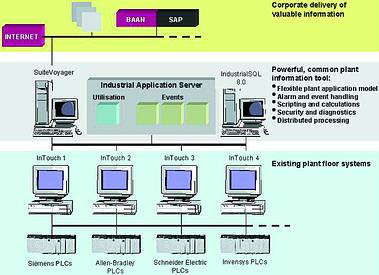
To manufacturing users, the new industrial application server (IAS) from Wonderware may look and act a lot like a tag server, but it is actually much more than that. The new IAS provides a new tier of realtime data acquisition, alarm and event management, data manipulation services and collaborative engineering capabilities that have been designed from the ground up for use in industrial environments.
The new IAS from Wonderware is built upon Invensys' new ArchestrA architecture. ArchestrA is a comprehensive plant automation and information architecture designed from the outset to extend the life of legacy systems by making the best use of the latest software technologies. Offerings built using this architecture empower decision makers to achieve their business goals without abandoning prior investments in automation systems, production processes or intellectual property. The new Wonderware IAS makes full use of the core services of this software architecture to provide a new class of application server for the manufacturing and process industries.

Why use servers at all?
A decade ago, the development of typical automation software applications was relatively simple in concept. Programmable logic controllers (PLCs) and dedicated process controllers ran equipment or process loops. Plant floor sensors, actuators and recorder devices were interfaced to these control platforms while human-machine interface (HMI) software provided the PC-based visualisation needed to interact with the process under control.
The problem was that as engineers built more functionality and sophistication into their applications, they were adding more data tags, a lot more scripting and many more alarms. In addition, to scale systems up to expand or enhance production lines meant they had to add more PCs, PLCs and control devices. This meant networks needed to grow as well and they were usually segmented so that throughput would not be impacted.
While system engineers borrowed heavily from the client/server technology deployed in the business world, they could not really use it efficiently because of the difference in the nature of the business and industrial worlds. They were able to offload tags and scripts to a common server, which reduced network traffic and client duplication. They used communications servers to offload data traffic management. Calculation engines were added to process data on-the-fly for use elsewhere within an ongoing process. But each of these was a separate server implementation that was not typically integrated with other application tasks.
For example, a tag server was usually deployed to acquire data from specified plant floor devices in an industrial automation application. It would then scale the data, check it for alarms and events and distribute the processed data to any user requesting it. This is how plant floor operators are notified when an alarm or an event occurs that needs their attention and intervention.
Tag servers are configured as part of a complete application system and they are mainly responsible for offloading the data handling and manipulation functions between the HMI layer and the device control layer in the application. Their primary purpose is to maintain regular 'snapshots' on the state of the process under control. In large applications, users may deploy multiple tag servers to handle tags for specific groups of devices. This presents yet another configuration problem since each tag server must be programmed and addressed differently as a separate element of the application.
While all of these approaches helped with the issues of the moment, they only increased the life cycle application problem. As applications grew bigger and more complex, new problems were created for administering networks, managing application changes, scaling applications to add new lines or to enhance application functionality and efficiency - which all goes to show that change management has become an increasingly large cost element in re-engineering.
The only realistic solution today is to borrow a page from the business IT world and deploy application servers. However, it will take more than just copying standard application server technology to meet the needs of the industrial world. The industrial world has typically lagged the enterprise world by several years in its adoption of IT technologies and adaptation of them to the factory floor. This has meant that application servers were most often used for business applications, serving up application modules and database information for use in customer resource management, e-business, financials, human resources and other enterprise applications. Most application servers provide services in a transaction-based environment, however, and that does not work in an event-driven industrial environment because the ground rules in a factory are different to those in an office.
An industrial application server performs the same basic logic functions as its business counterparts, which is providing services and data to multiple applications - but it must do so while fulfilling unique requirements of the industrial world. For example:
* It must operate in realtime so that it can handle millisecond transaction and event speeds.
* It must be able to monitor and respond to extremely high volumes of asynchronous data and event messages (thousands of messages per second).
* It must be a peer-to-peer implementation, to facilitate interaction with thousands of plant floor devices as well as to provide access to applications from multiple sites, both local and remote.
* It must be deterministic, providing the ability for things to be done in a set order.
* It must facilitate the use of information as part of the process under control because certain events rely on receiving data during the process, not after it is completed.
* It must provide a reliable, application development environment.
The new IAS from Wonderware provides all of this capability and more, all in one product. The company has created a server that complements existing factory software, providing a wide array of services that are usable by all industrial automation applications. This includes services such as licensing, security, internationalisation (without multiple dictionaries), configuration, deployment, events, messaging, scripting, alarming, peer-to-peer services and integration of vast numbers of plant floor devices.
Removing these various services from individual applications and providing them in an application server environment offers many benefits to the system designer. For example, it eliminates tag limitations, allows distribution of loads, facilitates re-use of code from one application to another, adds structure to projects (using the plant model), simplifies maintenance and change propagation, provides enhanced communications, and offers centralised security features.
The IAS approach to security brings unparalleled robustness to industrial applications because it offers data model security at the lowest possible level of granularity. It extends the Microsoft Windows security model down to the physical equipment layer, providing security attributes that specifically match factory requirements. At this level, data is arranged according to the area model and the plant model. Users still enjoy the same centralised ease of log-in procedures as the Microsoft model, but IAS expands upon it once clients are inside the system. Carrying the security model down to the equipment and process loop level provides much greater granularity of secured access.
This security approach is needed because, while plants typically have a lot of highly skilled engineers and technicians who may be capable of making changes in applications, those applications must be secured at a low enough level that only authorised persons can make adjustments to them at authorised times. Because of the deterministic nature of factory automation, individual skill and authority levels are matched against the role played with any specific piece of equipment or any process loop, not just with individual permissions. For example, a plant manager may have access to any point in a production process, but that does not mean that it would be wise to intervene in a process anytime he or she wishes, since an intervention at an inappropriate time might disrupt normal plant operations.
Summary
The IAS is a versatile new product from Wonderware that satisfies the evolving requirements of a maturing automation marketplace. By incorporating the innovative Invensys ArchestrA software architecture, the IAS provides unparalleled scalability, integration and architectural freedom to become the much-needed platform on which users can evolve today's industrial applications.
The IAS provides the centralised advantages of a single name space, as if it were merely one server, but in reality its peer-to-peer, distributed features enable seamless integration of the thousands of devices found in any plant floor topology. This serves as the foundation on which IAS' powerful, modular, plant-centric model provides the most efficient path forward for integrating today's existing industrial systems with tomorrow's new technology deployments.

For more information contact Mike le Plastrier, Futuristix Advanced Control Systems, 011 723 9900, [email protected], www.futuristix.co.za

© Technews Publishing (Pty) Ltd | All Rights Reserved